Sheldon Brown's
Bicycle Glossary Dr - z

|
![]()
See my article on Tandem Brakes.
Since air resistance is the major limitation on bicycle speed, many of the tactics used in bicycle racing are based on exploiting this effect.
When Pierre Lallement added pedals to a draisine in the 1850s, the bicycle was born.
Draisines are still made for small children, intended as a transitional vehicle between a tricycle and a bicycle, but I don't recommend buying these, because you can acheive the same effect by unscrewing the pedals from a real bicycle.
See also threaded driver.
The drivetrain area of a frame consists of those parts of the frame that are directly stressed by the drive train parts, specifically the chainstays, down tube, and seat tube.
![]()
![]()
Smaller drop = a higher bottom bracket. This dimension is often preferred to the bottom-bracket height dimension, because it is the same whatever tires are installed on the bicycle.
A bicycle with a shorter drop (higher bottom bracket) will be less at risk of striking a pedal on the ground during high-speed cornering or obstacle jumping.
A bicycle with a longer drop (lower bottom bracket) will be slightly faster, and easier to mount/dismount.
The most common style of drop handlebar is the "Mæs" bend. Variations include the "randonneur" and "anatomic" bends.
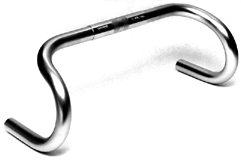 Mæs |
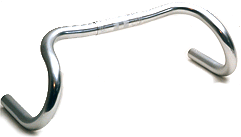 Randonneur |
|---|
The main advantage of drop handlebars is that they offer several different hand positions. For longer rides, the ability to change positions is very desirable. Riding for a long time in any one position tends to be uncomfortable.
People who think they don't like drop handlebars are often actually objecting to the position of the bars on the drop-bar bikes they have tried.
Bikes with drop bars often have the bars mounted rather low and far forward, so that the rider has to lean forward quite a lot to reach the bars, especially the lower "drop " position. If these people tried a bike where the drop bars were placed higher, and closer to the saddle, they might find they really liked them.
I have an article on this topic, called "Hands Up."
Most newer drop handlebars come in either single-groove or double-groove versions, with grooves along the upper section to acommodate brake (and shift) cables running under the handlebar tape.
These grooves are totally unnecessary. Indeed, the double-groove variety is often rather uncomfortable due to the rear groove's causing sharp ridges against the rider's hands.
![]()
![]()
Track and BMX bicycles do not have rear dropouts; they use fork ends that open to the rear.
A current fad has led to the revival of this inferior forkend style for single speed bikes.
Rear dropouts come in two styles:
With horizontal dropouts, it is possible to mis-align the wheel in the frame if it is installed carelessly. The axle nuts or quick-release must be tightened quite securely, or the chain tension may pull the axle askew.
Vertical dropouts are generally intended for use with derailer gearing, and do not permit any adjustment of the position of the rear wheel, so there's no way to regulate chain tension if you don't have a derailer or pulley type chain tensioner.
A few single-speed or internal-hub gear bikes use vertical dropouts with an eccentric bottom bracket to permit chain tension adjustment.
White Industries makes a special hub with an eccentric axle, also to permit vertical dropouts to be used with a straight chain run.
On derailer-equipped bicycles, the rear derailer is attached to the right rear dropout, either directly to a hanger that is part of the drop out, or by way of an adaptor claw.
Dropout spacing varies among different styles of bicycles
| Forged Dropouts | |||
|---|---|---|---|
 |
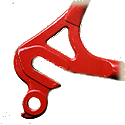 |
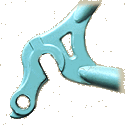 |
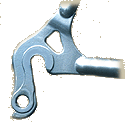 |
| Horizontal Dropout Campagnolo 1010 |
Horizontal Dropout Short |
Semi-Vertical Dropout | Vertical Dropout |
| Stamped Dropouts | Investment Cast | ||
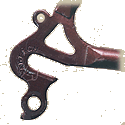 |
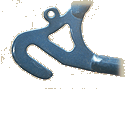 |
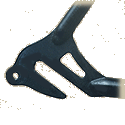 |
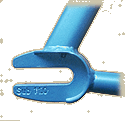 |
| With Hanger | Without Hanger | Raleigh 3-speed | Track Forkend Not a dropout! |
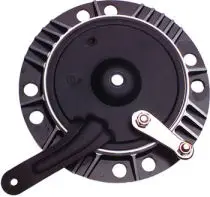 Drum Brake
Drum Brake The drum may be the inside of an oversized hub shell, or may be a separate unit which screws on to the side of the hub, by threads like those to which freewheels attach.
Drum brakes are common on automobiles and motorcycles, but fairly rare on bicycles, mainly due to their weight. The greatest advantage of a drum brake is that it is unaffected by rain. Drum brakes are commonly used as drag brakes on tandems. Also see the articles on Drum Brakes and on Tandem Brakes.
![]()
![]()
Sometimes people speak of bicycle tires as if they suffer from dry rot, but this is not generally correct. (The exception would be for cotton-cord tires, but those pretty much disappeared by the mid 1960s, at least as far as clinchers are concerned.)
What people commonly call "dry rot" is a deterioration of the rubber, usually on the sidewalls. This is particularly common with gumwall tires that have been exposed to ozone damage. (A common cause of this is storing a bicycle near a household furnace. The brush-type motors on such furnaces often create sparks, which in turn create ozone.)
This type of damage is ugly, but not structurally significant, as long as the cords (fabric) of the tire are intact.
Generally, if a tire isn't lumpy/misshapen when inflated, and has not had the tread area worn too thin, there is no reason to replace it, no matter how ugly the sidewalls get.
Instead of using these easily understood common English words, they have invented the terms "drive-side" for "right" and "non-drive-side" for left. (This relates to the fact that the chain drive is on the right side.)
As if this silly jargon were't confusing enough, they sometimes further muddy the waters by abbreviating these phrases as "D.S." and "N.D.S."
The main feature of dual-pivot brakes is that they are easier to keep centered, due to the way the arms are linked together. They can have more mechanical advantage (and a resulting rest position closer to the rim) than conventional sidepulls. Newer designs permit fine tuning the centering of the arms by simply turning a screw.
The principal disadvantage of dual-pivot brakes is that they don't track imperfect rims as well as single-pivot sidepulls, possibly causing pulsating braking.
Thanks to Mark McMaster for his help with this entry.
"DT" stands for "Drahtwerke Tréfilerie." "Drahtwerke" means "wire works" in German; Tréfilerie means the same thing in French.
![]()
![]()
Because an earlier patent for an inflatable tire had been taken out in France, his 1888 patent was invalid in Scotland, so he moved to Belfast, Northern Ireland, and started manufacturing tires in 1890.
The Woods valve is also sometimes referred to as a "Dunlop" valve.
The Dunlop tire company which he started still exists, but stopped making bicycle tires in the 1960's. This caused a crisis among cyclists for a couple of years, because Dunlop bicycle tires were incontestibly the finest available. The Dunlop "HPRR" (High Pressure Road Racing) tire was the high-performance "clincher"
There are interchangeability issues with older Dura-Ace parts, and I have an article on Dura-Ace interchangeability.
The threading chosen was 1" x 24 tpi, same as a standard 1 inch headset, except that the left side was a left thread.
This was rather a good idea, but never caught on.
![]()
![]()
![]()
Last Updated: by Harriet Fell